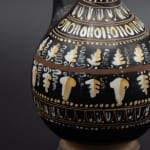Gnathian black-glazed Epichysis, 400 BCE - 300 BCE
Terracotta
17.8 x 7.6 cm
7 x 3 in
7 x 3 in
OF.209
Further images
Gnathian vases are a variety of pottery that developed in Apulia in the 4th century BCE. The name derives from the ancient city of Gnathia (now Egnazia) in eastern Apulia,...
Gnathian vases are a variety of pottery that developed in Apulia in the 4th century BCE. The name derives from the ancient city of Gnathia (now Egnazia) in eastern Apulia, as it was in this location that the first examples of this particular style were discovered in the mid-19th century. Such vessels were produced in southern Italy for around one hundred year, from the mid 4th century B.C. until the late following century. With their glossy black glaze, and the frequent presence of gadroons and plastic edges, they tend to imitate metal ware. They differed from other types of pottery in that paints were applied directly to the glazed body of the vase, as opposed to techniques like red-figure in which colour was applied using clay slip as part of the three-phase firing technique. It has been theorised that the development of the Gnathian technique was linked to the tendency in Apulian red-figure pottery of the time to add decoration to the necks and shoulders of the vases in various colours, including white, yellow, orange, and red. Common vase shapes for this sort of pottery were bell kraters, pelikes, oinochoai, and skyphoi. They often depicted themes such as Dionysiac motifs, theatrical scenes, images from the life of women, and Erotes. Although the technique developed in Apulia, Gnathian vases are also found within the Campanian, Sicilian, and Paestan fabrics.
An epichysis is a kind of jug with a squat body, a high slender neck ending in a pinched beak-spout tilted sharply upward, and a high raised handle that slightly protrudes from the spout; Epichyses were used to serve wine or to fill oil lamps through their accurate spout.
Our example is entirely black-glazed (except for the two clay-red colored bands that embellish the foot), and beautifully decorated: the high quality of the black glaze (glazed during the firing process) provides an ideal support for the decorative patterns painted in white or brownish/gold yellow highlights that occupy the belly of the vessel. The decoration is arranged in friezes whereas the main decor consists of a garland of alternating vine leaves and grapes.
Bibliography
Trendall, A.D. Red Figure Vases of South Italy and Sicily. London: Thames and Hudson, 1989.
An epichysis is a kind of jug with a squat body, a high slender neck ending in a pinched beak-spout tilted sharply upward, and a high raised handle that slightly protrudes from the spout; Epichyses were used to serve wine or to fill oil lamps through their accurate spout.
Our example is entirely black-glazed (except for the two clay-red colored bands that embellish the foot), and beautifully decorated: the high quality of the black glaze (glazed during the firing process) provides an ideal support for the decorative patterns painted in white or brownish/gold yellow highlights that occupy the belly of the vessel. The decoration is arranged in friezes whereas the main decor consists of a garland of alternating vine leaves and grapes.
Bibliography
Trendall, A.D. Red Figure Vases of South Italy and Sicily. London: Thames and Hudson, 1989.











